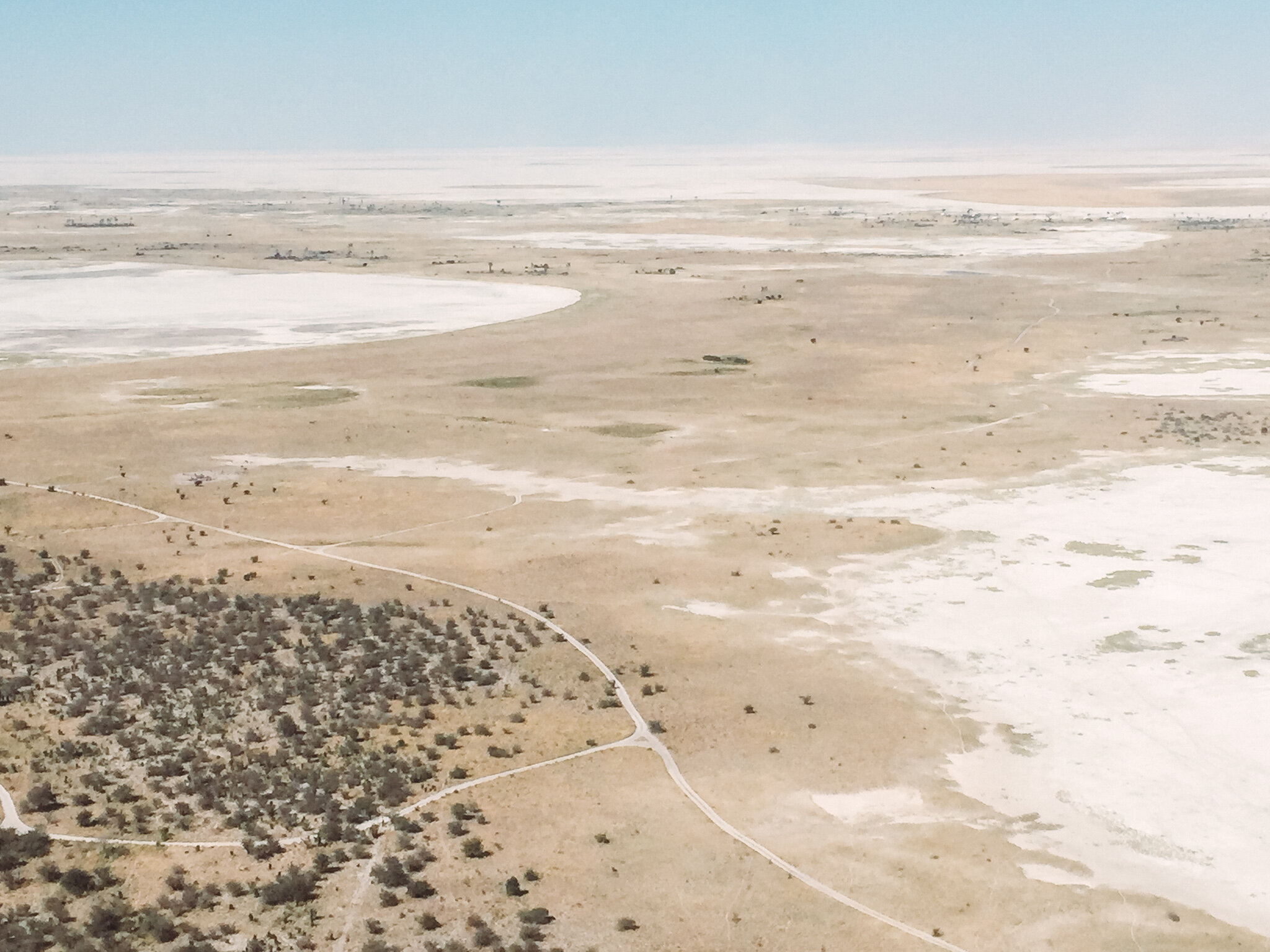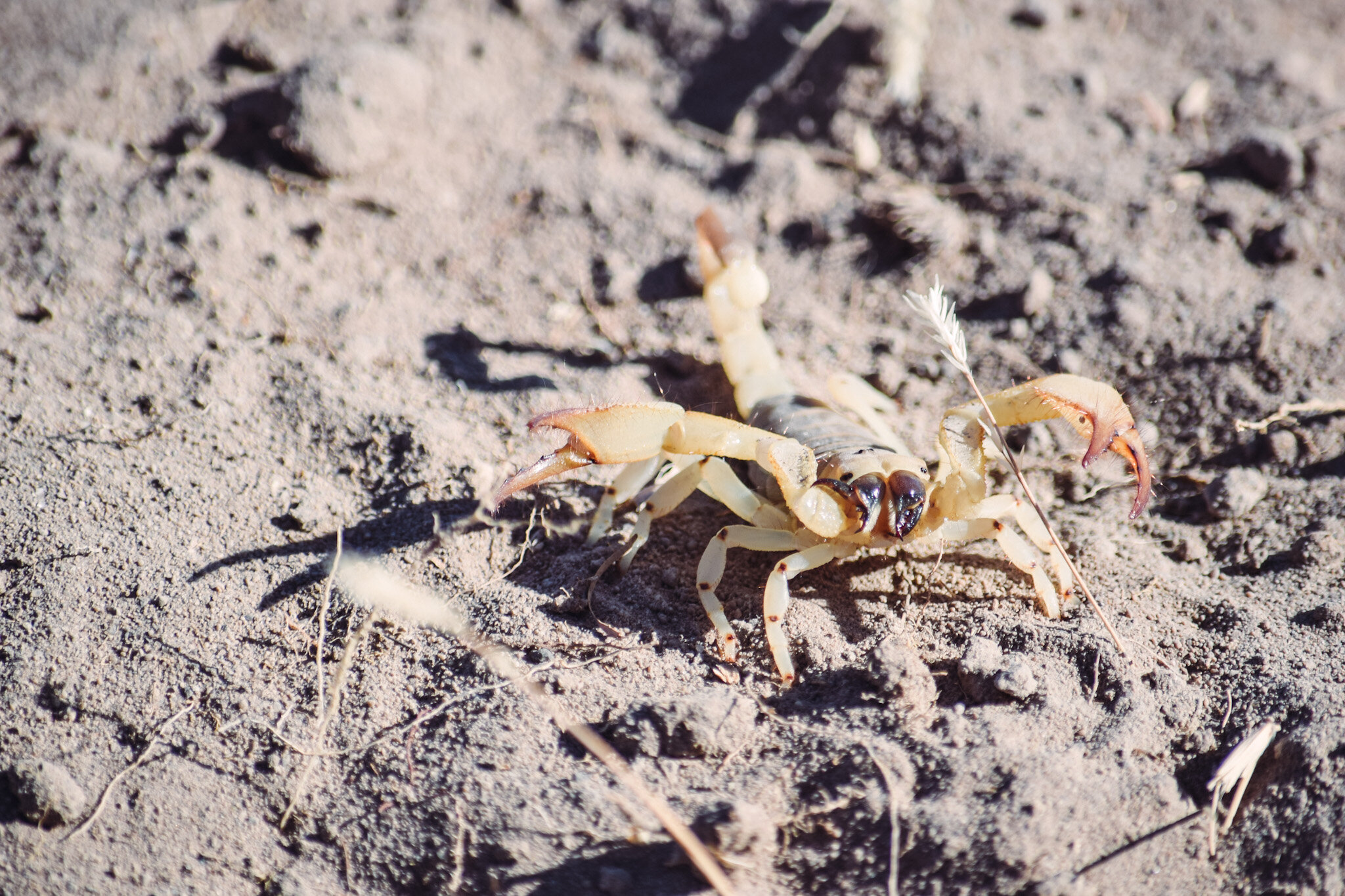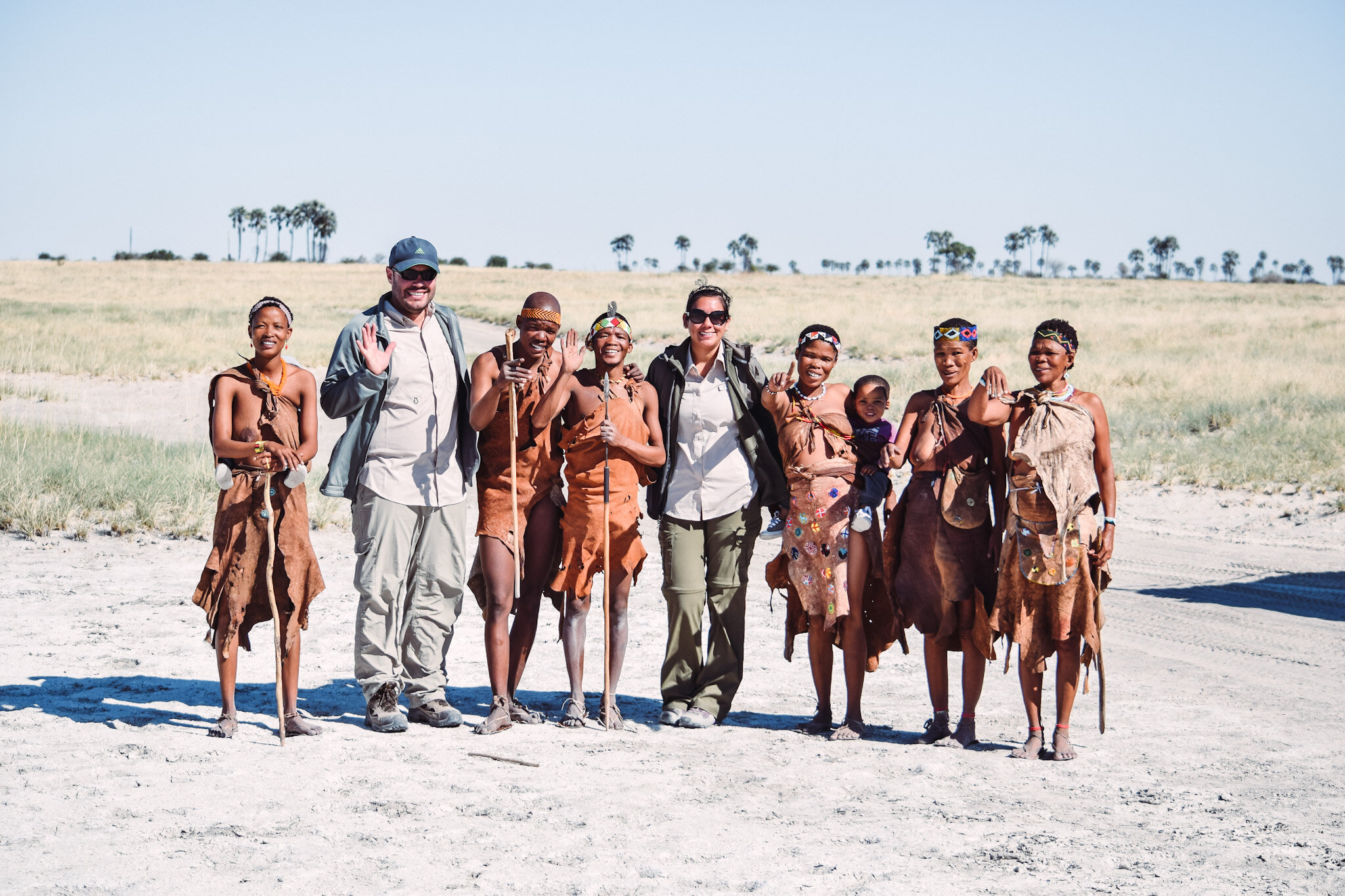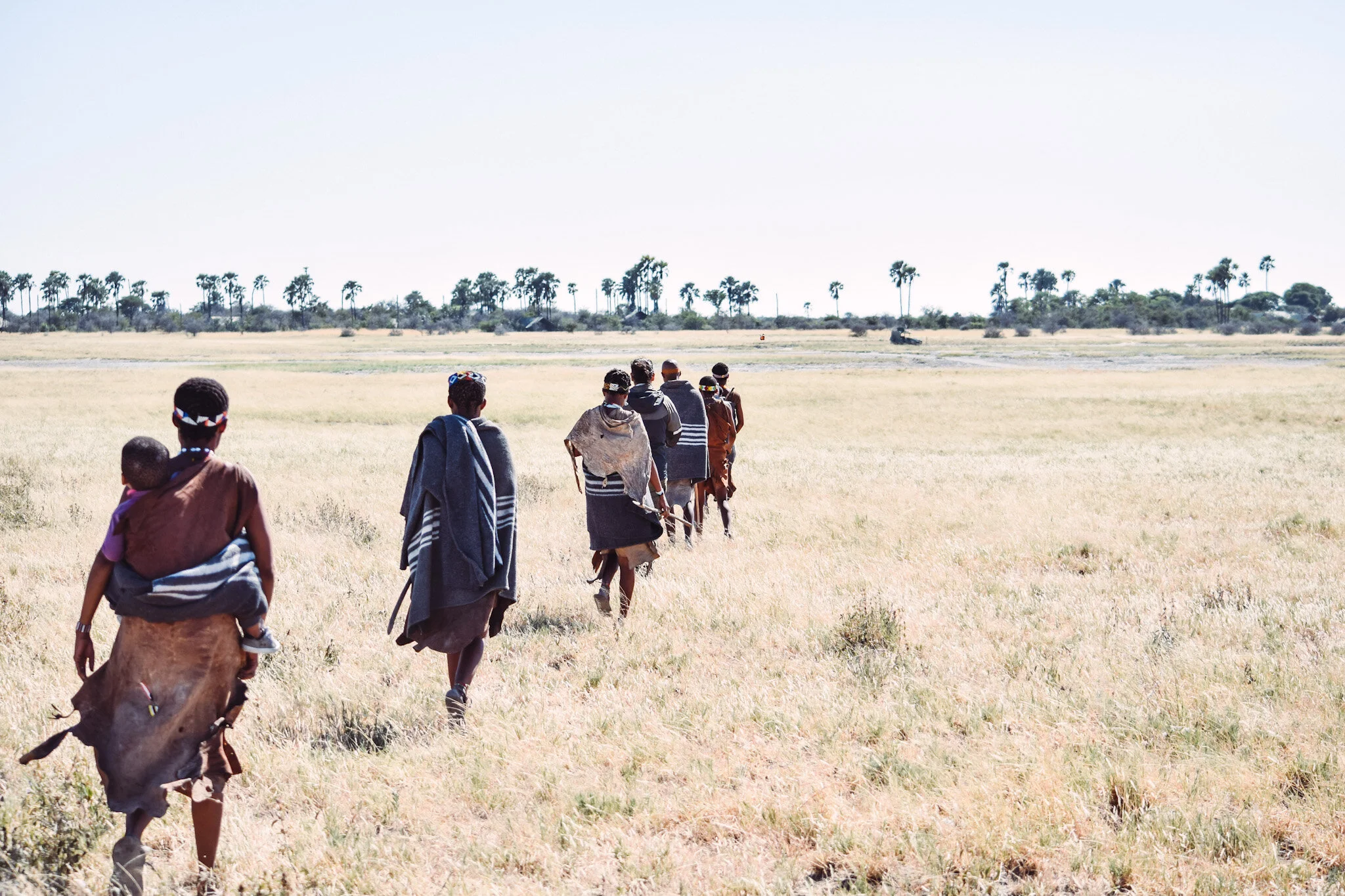Makgadikgadi Pans National Park
My awe with the salt pans and San Camp started from the air. As we were nearing the camp and landing strip, I saw something I’ve never seen before from the air – a huge area of white land that looked like dried up lakes. Turns out, that’s exactly what the salt pans are – an enormous ancient dried up saltwater lake and the pan in Botswana is among the worlds largest.
Andrew and I were already planning to be in Botswana for a 4 day safari and felt we couldn’t pass up an opportunity to see the salt pans and meerkats (link to meerkat post). So, we added 2 nights to our trip and booked the incredible San Camp. When we arrived, we went on a short game drive and saw many herds of zebra and wildebeests. We were surprised to learn the area has the second largest migration in Africa, after the great migration in Kenya/Tanzania. The wildebeests and zebras travel to the salt pans during the wet season since they fill with drinking water. In the dry season, the pans dry up and the animals migrate out of the area. This was our first safari in a desert with woodland and grassland areas so we were pleased to see new animals such as the ground squirrel, spring hare, slender or yellow-tailed mongoose.
The Salt Pans
For one of our afternoon activities, we took quad bikes out on the pan. The quads have significantly less impact on the pan when compared to a safari vehicle and we all want to leave the pan as close to their natural state as possible. We drove straight out onto the pan for about 20 minutes; when we stopped, there was only white salt pan in every direction. No camps, no grass, no civilization.
The pan itself was crunchy – yes, crunchy! With each step we took there was a crunching noise. As the pan dries out from the rainy season, the mud and clay leftover become stiff and form what looks like scales or craters. I’m no astronaut but from what I’ve seen in photos, the pan looks similar to the moon’s surface - full of tiny craters.
Sweet Silence
After we took some time looking around our guide asked us to walk in opposite directions and walk for about 300 steps out onto the pan. He said to take 5-10 minutes by ourselves and lie down and experience silence. Andrew and I looked at each other, a little skeptical and started walking in opposite directions. After ~300 steps, I looked back and our guide and quads were black dots in the distance and I could barely see Andrew. Suddenly, without my feet crunching down on the dried up pan, I heard it – nothing. I had never really heard silence before. I could hear my heart and my ears throbbing from blood circulating but that was all. I laid down and thought about how life-changing this was – hearing nothing. There was nothing to get in the way of my thoughts, nothing to distract me, just me, my body and my mind. A bird flew by and broke up my silence for a few seconds; but other than the bird’s call, I heard nothing but my body’s blood circulating for 10 minutes. There are many times in my everyday life when I wish I could get back to that moment of silence and I feel privileged to have experienced it.
Walking with an aardvark
Our second night, we went on a night game drive. We previously went on a night game drive in Lake Manyara, but this one was special. We had spotted a rare brown hyena, which was pretty exciting but towards the end of the drive, Greg - our guide - spotted an aardvark. We were all pretty excited because aardvarks are very hard to spot since they’re nocturnal and shy. Greg had only seen a few and this was our first. As it started walking past the range of the spotlight, Greg asked if we were up for an adventure. Of course we said yes! He told us he had seen a couple videos of people walking alongside aardvarks but that it was very uncommon and hard to do. Being totally honest here, my first though was “what about lions and hyenas?”; turns out it wasn’t a thought, it was said it out loud but Greg told me not to worry…..so, we hopped out of the safari vehicle with nothing but a flashlight and an aardvark in the distance. We followed him from about 20 meters behind. When the aardvark stopped and looked back, we stopped in our tracks and put out the flashlight. When we heard him walking again, we’d flip on the light and slowly and quietly walk. Greg would also scan the surrounding area with the spotlight to deter any curious animals and to put my nerves at ease.
I was pretty nervous but at the same time it was thrilling to be out in nature where we have little control and to be trailing this exotic creature, something very few people have ever done. This was a real adventure, not a tour where you pay $100 to walk with an aardvark! We continued this for a good ¾ mile until we lost him. He went over a hill and when we got up to the hilltop we lost his trail. By this time, we had walked so far we were actually closer to our tents than the vehicle so we continued walking to the tents and called it a night. Poor Greg had to walk back to get the safari vehicle.
Zu’Hoasi Bushmen
One morning we had the opportunity to spend time with the Zu’Hoasi Bushmen from the Western Kalahari, one of the oldest indigenous people on the planet. The family stays a few months each year at San Camp to spend time with guests. We met them out in the grasslands and after introductions, started walking. The group had 4 women, 2 men and 2 babies, all in traditional dress despite the chilly breeze. The plan was to simply walk around the concession and the Zu’Hoasi family would teach and give us insight to their ancient way of living off the land. The entire time, the family spoke only in their native click language with one of the men translating what the leader was saying for us. Hearing their click language all morning made the experience all the more authentic. On our walk, the Bushmen explained how they could tell which animals were in the area by the dung and showed us which plants they could eat or use for medicinal purposes.
Scorpion Digging
At one point, they found a hole in the ground and asked us if we wanted to see a scorpion. When we said “of course!” they started digging with small sticks. Scorpions burrow about a foot underground but they don’t make a straight tunnel to where they sleep; their tunnels twist and turn down to where they live to dissuade predators. To find the scorpion, our Bushmen dug until the path turned and then stick their fingers in the hole to see if they could feel the scorpion – crazy, I know! They continued this iteration 4 or 5 times and then we saw it. They pulled the scorpion all the way out and held it by the stinger and front legs so it couldn’t sting. With the scorpion in a stretched out position, our guide put the back of the scorpion in his mouth – he was using his saliva to clean off the dirt so we could see the scorpion better! This took us by complete surprise!
To finish off our walk, the Bushmen wanted to show us how they build fire. So we sat down and watched them gather all the materials, starting with Zebra dung, from the nearby land. Once the fire was ablaze, the men played a traditional hand game which is supposed to help prepare the younger boys for hunting. The women looked on and helped sing and clap while smoking tobacco and holding babies on their back. The experience was such a great way to see the land from a completely different culture’s point of view. And to learn about their lives and hear their language at the same time was like watching National Geographic, but live!
San Camp
San Camp consists of 8 white tents on the edge of the salt pans and is on a private concession within Makgadikgadi National Park. 6 tents are guest accommodations while the others are guest lounging and dining areas. The tents made you feel as if you had stepped back to the 1940’s safari era, with no detail overlooked. There were old trunks as tables, copper basins for sinks, black and white family photos and a sitting area outside the tent for enjoying sunny afternoons.
Our guide – Greg – was the BEST safari guide we’ve ever had (we’ve probably traveled with 8-10 safari guides) and he was SUPER knowledgeable about the area. I learned more about the Salt Pans and surrounding ecosystem than I have learned at any other safari location. The food was possibly some of the best we’ve had period, much less out in the bush. Andrew was especially impressed with the Botswana beef steaks we had the first night and the afternoon tea time snacks (cookies, quiches, scones!) were perfect for a quick indulgence before our afternoon activity. When arriving back at camp in the evenings we had pre-dinner drinks and appetizers out by a camp fire, followed by a delicious 3 course dinner in the main tent. San Camp was such a special place I actually cried a little when we boarded the plane to leave.










